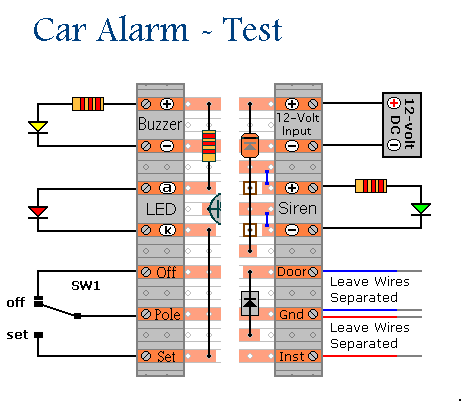Build this vehicle alarm circuit yourself using veroboard and cheap off-the-shelf components.
Introduction
The prototype of the Car Alarm was built using only the Stripboard Layout as a guide. So - if you have faithfully reproduced that layout - you will have a working circuit.
Once you're satisfied that your layout is correct - and you have made a careful and thorough check of the underside of the board - it's time to power-up the circuit and test its operation. This is always an anxious moment. If you construct a lot of circuits - you might consider building the
Current Limiting Power Supply - or alternatively - you could add the Simple Current Limiter to your existing PSU. Both will let you set an upper limit on the amount of current supplied to your circuit - and so protect it from any serious damage.
Test Setup
|

|
|
|---|
|
If You Find a Problem
If - in the course of the test - you find that something is not working properly, then a careful inspection of the relevant area of the circuit board should turn up the cause of the problem.
If an LED is not lighting - check that it's connected the right way round. If you're not using the specified transistors - check the pin configuration. Even if your transistors look like BC547s and BC557s - they may still have a different pin configuration.
Check the board for short-circuits caused by component leads touching each other. It can also happen that the stripboard itself is faulty. I have seen cases where the copper tracks have not been completely severed from one another during manufacture. Where you've cut the board to size - look for small loose strands of copper left behind by the saw.
If you've built your circuit using the specified components - and you've followed the step-by-step construction guide described on the Car Alarm - Support Page - then the chances are that any bug will be caused by something minor - a component connected the wrong way round - a missing or unwanted solder bridge - an incomplete cut in the track etc.
If you can't see anything obvious then adopt a systematic approach to faultfinding. Begin by double-checking that all of the cuts in the tracks have been made, that they are all - In The Right Place - and that they sever the track completely. Use a magnifying glass - and backlight the board. It only takes the smallest strand of copper to cause a problem.
When you're satisfied that the tracks have been severed in all the right places, check that you have made - and correctly placed - all seven solder bridges. Mark each bridge with a felt-tip pen - or something similar - so that it can be easily identified later.
Next - carefully examine the full length of each track. Use a magnifying glass - and backlight the board. Look for unwanted solder bridges. Your felt-tip markings will tell you which ones should be there - and help you identify any that shouldn't be there.
If all else fails and you still haven't found the cause of the problem - work your way through the assembly instructions on the Support Page. Check each individual component and link - to make sure that it's present and correctly positioned.
Print out the drawings and mark off the components as you go. Take your time and examine each individual component carefully. Pay particular attention to the orientation of the diodes - transistors - and electrolytic capacitors.
Car Alarm - Support Material
 SUGGESTIONS
SUGGESTIONS
 SUGGESTIONS
SUGGESTIONS